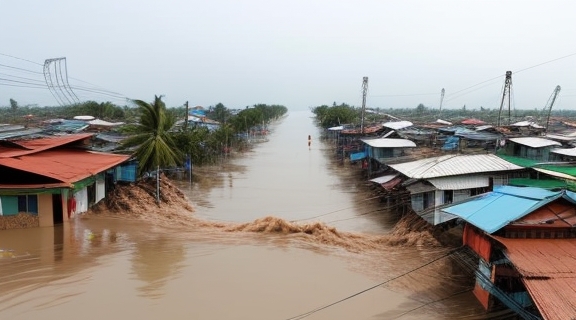
As Cyclone Mocha made landfall in Myanmar, numerous individuals sought refuge in monasteries, pagodas, and schools, as the storm ravaged the region with unprecedented force. The cyclone crossed the northwestern coast of Rakhine State, south of the Bangladesh border, around 1:30 pm (07:00 GMT) on Sunday. Its powerful winds, reaching speeds of up to 250 kilometers per hour (155 miles per hour), uprooted trees, toppled pylons and cables, and triggered a tidal surge that submerged streets in the low-lying areas.
Reports from rescue services in Myanmar indicate that two people lost their lives in a landslide, while local media reported the death of another individual who was struck by a falling tree. The cyclone’s path spanned from Sittwe in Myanmar to Cox’s Bazar in Bangladesh, the latter being home to nearly one million Rohingya refugees, predominantly Muslims who were displaced from Myanmar during a military crackdown in 2017. This crackdown is presently under investigation for potential genocide by the International Court of Justice.
Fortunately, the primary Rohingya refugee camp in Cox’s Bazar appeared to have avoided the worst impacts of the cyclone. However, it will take some time to assess the full extent of the damage caused by Cyclone Mocha.
According to Al Jazeera’s Tanvir Chowdhury, a comprehensive evaluation of the cyclone’s aftermath will require days and weeks due to the presence of small coastal islands where communication is limited, and fishermen often disregard warnings.
Initial reports from Myanmar suggest that Sittwe, the capital of Rakhine State, suffered significant damage. Local media shared images of billboards strewn across roads, fallen trees, and pylons obstructing streets. Additionally, a flash update from the UN Office for the Coordination of Humanitarian Affairs (UNOCHA) on Sunday reported extensive flooding, reaching up to 3.5 meters, in the low-lying areas. Myanmar’s military information office confirmed damage in Sittwe, Kyaukpyu, and Gwa townships, as well as the displacement of roofs from sports facilities on the Coco Islands, located about 425 kilometers (264 miles) southwest of Yangon, Myanmar’s largest city. The destruction of a communication tower further exacerbated the situation by disrupting internet and phone services, impeding damage assessment efforts.
UNOCHA stated in its update that the initial reports indicate extensive damage, particularly affecting vulnerable communities, including displaced individuals.
Myanmar has been facing a severe crisis since the military coup in February 2021, leading to mass protests and subsequent armed rebellion against the military’s rule. The people in Rakhine State have endured years of conflict and displacement, with hundreds of thousands of Rohingya confined to temporary camps with restricted movements. The administrative control of Rakhine State is disputed between the military and the United League of Arakan (ULA), the political arm of the ethnic Arakan Army, which could further complicate relief efforts.
Numerous structures in Sittwe and Kyauktaw have suffered damage, leaving schools and monasteries, which served as shelters, without roofs. Khine Thu Kha, a spokesperson for the Arakan Army, reported severe damage across northern Rakhine and expressed concern for the well-being of the affected population.
In a separate incident, a rescue team from Myanmar’s eastern Shan State recovered the bodies of a couple who were buried in a landslide triggered by heavy rainfall in Tachileik township. Local media also reported the death of a man in Pyin Oo Lwin township, central Mandalay Region, when a banyan tree fell on him.